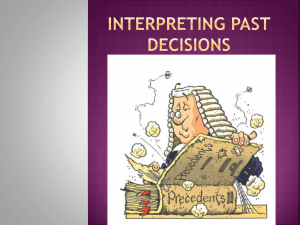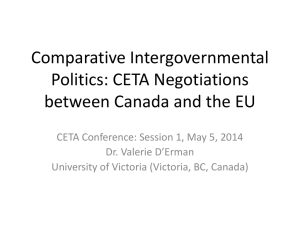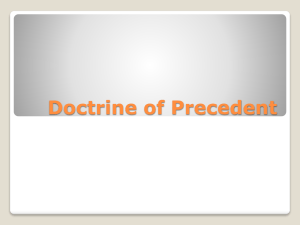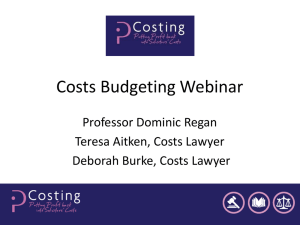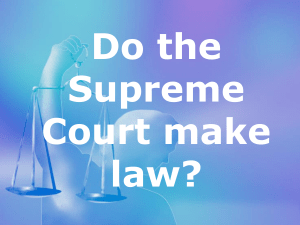JUDICIAL PRECEDENT
advertisement
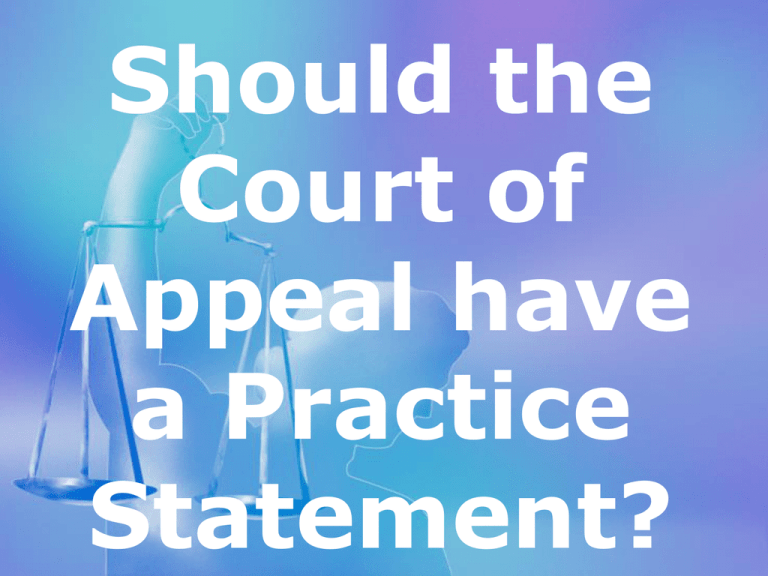
Topic 3 Should the Court of Appeal have a Practice Statement? Judicial precedent Topic 3 Powers of the Court of Appeal to change Judicial precedent previous precedents •Stare decisis: As with all courts the Court of Appeal (CA) believes that certainty in the law is very important. •The CA is bound by the Supreme Court and itself. •CA Tool box: The SC can use all the tools of precedent that other lower courts can, i.e. overruling, reversing, distinguishing. •Overruling their own decisions: The CA is not allowed to do this. They should refer any cases that might require overruling of their own or the Supreme Courts previous precedent to the Supreme Court. •The Young exceptions: The CA does have the power not to follow a previous binding precedent in limited situations first explained in the Young v Bristol aeroplane case of 1944. Topic 3The CA is split into two parts Judicial precedent •As most appeals stop at the CA it has more judges to deal with cases. •The court is organised into 2 separate parts to ensure judges with the correct expertise deal with the correct cases. • •The Civil Division: Deals with all Civil appeals such as contract law. •The Criminal Division: Deals with all criminal appeals. •As they deal with different law a precedent made in one part of CA, say Criminal, doesn't bind the other part of the court, in this case the Civil division. Topic 3 The Young exceptions Judicial precedent •Both the Civil and Criminal division are not bound by previous precedent in three situations: 1. Per Incuriam – Wrongly made law 2. Where the Supreme Court has made a new and conflicting precedent since the last CA’s decision on an area of law. 3. Where there are two or more decisions of the CA which conflict (say different points of law). For the Criminal division they have one further exception: 1. Where the previous precedent could lead to imprisonment of the D in the current case and this was seen as unfair. Topic 3 Per Incuriam Judicial precedent •If the previous precedent set by the CA made an incorrect interpretation of the then this doesn't bind the CA. •Example: Willams v Fawcett 1986 C was committed to prison for breach of a non-molestation court order, he attacked his wife. The paperwork failed to give details of when he attacked his wife as required by the Act. However, previous precedent had allowed the case to be won without the paperwork specifying the details of attacks. Held: Sir John Donaldson MR: These were important details that should have been present in the paperwork according the Act. The previous precedent was therefore wrongly decided though this is an exceptional case. Topic Conflicting 3 Judicial precedent decisions of the CA 1. If two precedents made by the CA appear to give different decisions then the CA can decide which one to follow. Example: Starmark v CPL Where the CA in the current case chose to follow the earlier of two decisions that conflicted on an issue to do with a rent review clause. Topic 3 Criminal Division Exception Judicial precedent 1. Where the law is misapplied or midunderstood and following a precedent based on this could mean a person going to prison then the previous precedent doesn’t have to be followed. Example: R v Spencer 1985 D’s were charged with ill treating mental patients in a hospital. Members of the jury were directed not to discuss case with a discharged juror, three members disregarded the direction. The issue was whether this irregularity affected the trial. Ratio: Since the Criminal Division was dealing with the liberty of the subject, that Division would not follow a previous decision where the interests of justice to an defendant required an earlier authority not to be followed; and that, accordingly, the court would apply those principles in determining the proper direction to be given to the jury. Topic 3 Should the CA be able to change Judicial precedent their own binding precedents? Reasons For • The Court of Appeal was in essence the final court of appeal for many cases • CA should have the same flexibility as the SC as it is the final appeal court in many cases. • CA should be allowed to develop the law as this would make the law more in tune with society. Reasons Against • Goes against the principle of Stare Decisis, i.e. consistency and predictability • Can appeal to SC if really important to do so. • Would allow too much flexibility and risk making the law unfair • As the power to change a courts own precedent could affect a large amount people only one court should have the ability to do this. Topic 3 Challenge to the rule in Young’s case Judicial precedent •From 1969 to 1979 Lord Denning tried to overrule CA and House of Lords binding precedents on four separate occasions. •The House Lords said that the CA could not do this on all of those occasions. •After Lord Denning retired there have been no further challenges by judges to enhance the powers of the CA. •Gallie v Lee - Lord Denning argued that Young's case exceptions are " a self-imposed limitation and we who imposed it can also remove it” •Broome v Cassell - House of Lords rebuked Lord Denning and declared that under the doctrine of judicial precedent it is necessary for all lower courts "including the Court of Appeal, to accept loyally the decisions of the higher tiers"— Lord Hailsham.


